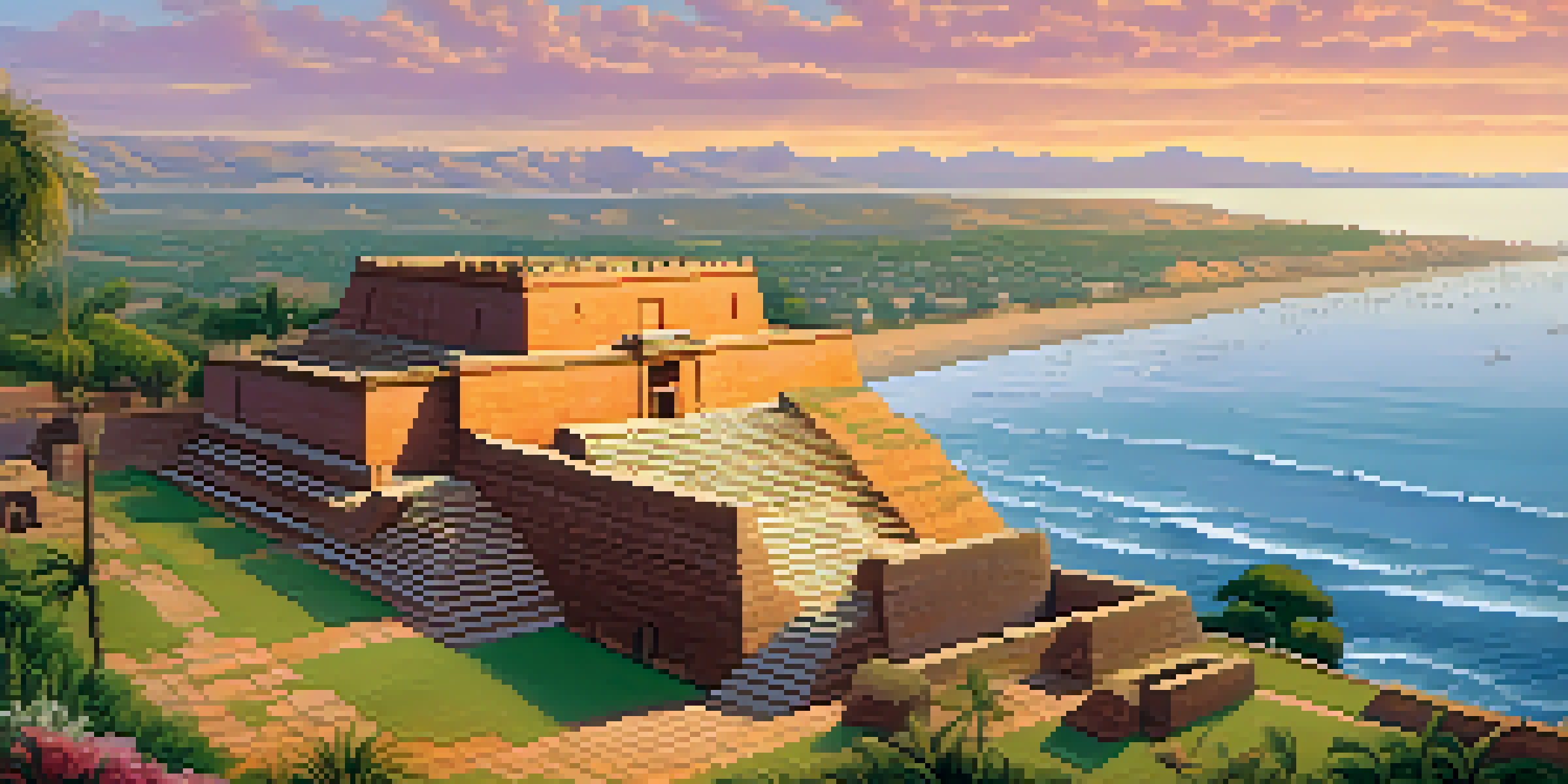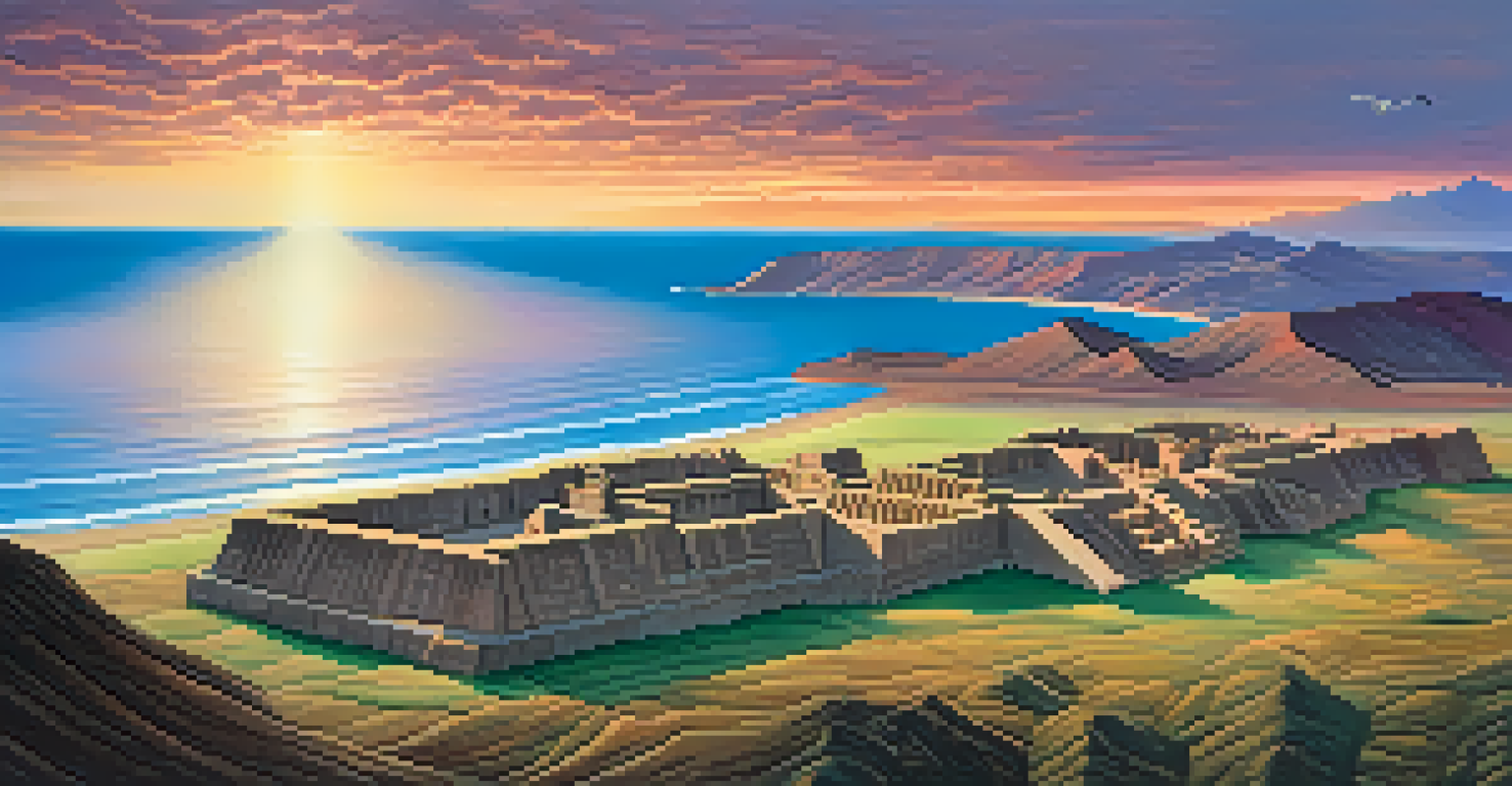The Sacred City of Pachacamac: An Incan Pilgrimage Site

Introduction to Pachacamac: A Pilgrimage Destination
Nestled along the Peruvian coast, Pachacamac is one of the most significant pilgrimage sites of the Incan Empire. This sacred city served as a religious and cultural hub, attracting worshippers from across the region. Its importance lies not only in its grand structures but also in the spiritual journey it represented for many pilgrims seeking the favor of the gods.
The past is never dead. It's not even past.
The name 'Pachacamac' translates to 'the Earth Maker,' and it reflects the reverence the Incas had for nature and their deities. The site is a testament to the intricate beliefs and practices that shaped Incan society. By visiting Pachacamac, pilgrims sought guidance, healing, and blessings from the powerful deities believed to reside there.
Today, Pachacamac continues to captivate visitors with its breathtaking ruins and rich history. As you walk through the site, you can almost feel the echoes of ancient prayers and rituals, making it a unique experience for history enthusiasts and travelers alike.
The Historical Significance of Pachacamac
Pachacamac was not just a religious site; it was also a bustling center of commerce and culture. Established long before the Incas, it became a melting pot of various cultures, with influences from different civilizations. Its strategic location near the coast allowed it to thrive as a trade hub, facilitating the exchange of goods and ideas.

The archaeological remains at Pachacamac reveal a rich tapestry of history, showcasing the architectural prowess of the Incas. From the impressive Temple of the Sun to the intricate pyramid structures, each site tells a story of devotion and craftsmanship. These remnants are a window into the spiritual and social dynamics of the Incan civilization.
Pachacamac: A Sacred Pilgrimage Site
This ancient site was a significant religious and cultural hub for the Incas, attracting pilgrims seeking blessings from their deities.
Understanding the historical backdrop of Pachacamac enhances the visitor experience, as it frames the significance of the site within a broader context. It invites us to appreciate the complexities of Incan heritage and the enduring legacy that continues to influence Peruvian culture today.
Architectural Wonders of Pachacamac
The architecture of Pachacamac is a striking feature that draws visitors from around the globe. The site is home to several impressive structures, notably the Temple of Pachacamac, which served as the primary shrine. This temple, built from adobe bricks, showcases the ingenuity of Incan engineering and their ability to create durable structures that have stood the test of time.
History is who we are and why we are the way we are.
Another architectural highlight is the Acllawasi, or House of the Chosen Women. This unique building housed women selected for their beauty and skills, who dedicated their lives to religious service. The layout and design of these structures reflect the social and spiritual hierarchies present in Incan society, providing insight into their way of life.
Walking through these ancient ruins, one can't help but marvel at the craftsmanship displayed in every stone and brick. Each building not only served a functional purpose but also embodied the spiritual beliefs and artistic expressions of the Incan people.
The Role of Rituals and Offerings
Rituals and offerings were integral to the spiritual practices at Pachacamac. Pilgrims often brought gifts, such as food, textiles, and even animals, to appease the gods and seek their favor. These offerings were a way to connect with the divine, showcasing the deep reverence the Incas had for their deities.
The act of offering was not only a personal endeavor but a communal one as well. Large gatherings would take place during religious festivals, where the collective prayers and offerings created a powerful atmosphere of devotion. This sense of community among worshippers highlights the importance of shared beliefs in Incan culture.
Architectural Marvels of the Incas
Pachacamac features impressive structures such as the Temple of Pachacamac and Acllawasi, showcasing the architectural ingenuity and spiritual beliefs of Incan society.
Today, many visitors participate in these traditions, leaving their own offerings as a means of honoring the past. This practice fosters a connection between modern visitors and ancient pilgrims, bridging the gap between history and contemporary spirituality.
Exploring the Surrounding Landscape
The landscape surrounding Pachacamac enhances its sacred ambiance, with stunning views of the Pacific Ocean and the Andes Mountains. This natural setting played a significant role in the spiritual practices of the Incas, as they believed the elements were manifestations of their deities. The mountains and sea were not just backdrops; they were integral to the rituals performed at the site.
The diverse flora and fauna of the area also contributed to the site’s significance. Many plants and animals were considered sacred, often featured in rituals and offerings. This deep connection to nature is a reminder of the Incan philosophy that emphasized harmony between humanity and the environment.
For visitors today, exploring the landscape can be a meditative experience, allowing for reflection on the spiritual significance of Pachacamac. Whether hiking nearby trails or simply enjoying the views, the natural beauty surrounding the site adds another layer to its allure.
Modern Day Preservation Efforts
As a UNESCO World Heritage site, Pachacamac is subject to preservation efforts aimed at protecting its cultural and historical integrity. Archaeologists and conservationists work diligently to study and restore the ruins, ensuring future generations can appreciate their significance. These efforts highlight the importance of safeguarding our heritage amidst modern challenges.
Local communities also play a vital role in these preservation initiatives. Engaging residents in conservation efforts fosters a sense of ownership and pride in their cultural heritage. By involving the community, these initiatives help maintain the authenticity of Pachacamac while also providing economic benefits through tourism.
Preservation of Cultural Heritage
As a UNESCO World Heritage site, ongoing preservation efforts aim to protect Pachacamac's historical integrity while engaging local communities in its conservation.
Visitors to Pachacamac contribute to these preservation efforts simply by exploring the site and learning about its history. Responsible tourism practices can help ensure that this sacred site remains intact for years to come, allowing people to connect with the past while supporting the local economy.
Visiting Pachacamac: Tips for Travelers
If you plan to visit Pachacamac, timing your trip is essential for a fulfilling experience. Early morning visits are ideal, as you can enjoy the tranquility of the site before the crowds arrive. Plus, the soft morning light enhances the beauty of the ruins, making it a photographer's dream.
Dress comfortably and prepare for varying weather conditions; the coastal climate can be unpredictable. Bringing water and snacks is advisable, especially if you want to take your time exploring the expansive grounds. Remember to wear sunscreen and a hat to protect yourself from the strong Peruvian sun.

Lastly, take your time to soak in the spiritual atmosphere of Pachacamac. Whether you’re wandering through the ruins or participating in a moment of reflection, allow yourself to connect with the rich history and cultural significance of this incredible site.